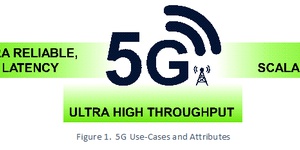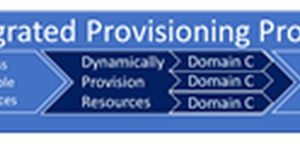
Whitepapers
Composers Increasingly Important in Cloud Orchestration Frameworks

The value of cloud computing is best realized when services function transparently and automatically at any scale. Although this nirvana goal is clearly in sight for both service developers and providers, platform offerings are moving toward it in progressive stages of innovation, arriving at an inflection point now in which new capabilities housed in service composer applications are moving us closer to the goal.
Early developments toward cloud computing in the last four to five years have provided good capabilities for creating virtual infrastructure resources, mostly on an a la carte basis. For example, systems have been developed to create virtual machines, storage pools, and virtual networking services typically within a single cloud architectural context such as VMware’s ESX and vCloud, Citrix’s XenServer and CloudPlatform, and Red Hat’s KVM and Enterprise Virtualization. Although there are resources to help stitch pieces together and some stages of orchestration across resource types to simplify provisioning, these have been largely focused on creating the pools and less on constructing whole services.
These foundations have been crucial in setting the baselines on which many XaaS capabilities available today have been realized. However, on their own they do not accomplish the goal of automating design and composition of whole services from multiple infrastructure categories or even multiple clouds. There has been significant progress made toward this goal in the past year, and we are now entering the composer applications phase, which provides new capabilities on top of resource provisioning to accelerate service design and delivery.
Composers are about creating offerings at the level of a consumable service, for example, burst computing, elastic archiving or application development integrating the services of multiple clouds. Composers assemble a service from multiple contributing sources and deploy it to a target user community. These sources can be virtual pools from within an individual cloud, combinations assembled from the resources of multiple clouds (private or public), and software to support important functions such as metering, monitoring, and SLA support.
These expanded capabilities can be seen in many deployment scenarios. Here are just two:
1. A corporate IT group creates an on-demand XaaS offering (on-demand compute or elastic storage backup) in a private cloud. The service is offered consistently across diverse user groups (multiple business units or functional areas). The common offering is realized from the underlying resources of two or more virtual infrastructure platforms, for example VMware vCloud and Red Hat Enterprise Virtualization. The composer simplifies and streamlines the job of integrating the facilities of the two virtualization environments into a single XaaS capability for the company.
2. An elastic storage archiving service is developed that blends enterprise on-premise and public cloud resources transparently. Designing the service is simplified by a composer app that automatically combines the private and public resources into a complete service offering more rapidly than if the combination had to be hand tooled. The service provides cost and scaling benefits to the organization, and the entire deliverable is produced more efficiently.
Examples of systems providing composer capabilities include IBM’s SmartCloud Orchestrator, HP’s Cloud Service Automation suite, Dell’s Enstratius Cloud Management platform, and Flexiant’s Cloud Orchestrator system. This year expect the Open Stack Heat orchestration project (currently under development) to yield an open-source platform for multicloud service composition (in conjunction with other functions it will provide).
The upside of this collection of developments for providers of cloud computing services is greater efficiency and speed, and increased agility in deployment of services. Leveraging the automation of a composer platform may improve speed and efficiency on the order of 50 percent or more, depending on the details of the environment. The opportunity to achieve improvements of this size in design and delivery efficiencies elevates the importance of composers in the toolkit planning providers of cloud services need to do for creation of their packages.
With this new level of service design and deployment functionality emerging at the upper layers of operators’ service management environments we can anticipate rapid production of a richer mix of applications and services. And because of their ability to accelerate time to value as well as the speed of innovation, we can expect this new powerful class of composer applications to occupy a place of prominence in operators’ plans for their cloud orchestration systems.
For more on cloud Hybrid Cloud Networks Face Challenges, but SDN May Be the Answer.
Click for more information aboutPaul Parker-Johnson.
You might like similar whitepapers


MODERNIZING THE CABLE SERVICE DELIVERY INFRASTRUCTURE

Global Pricing for SD-WAN

Virtualization Journey: Cable Companies Are on Their Way

Simplifying IP Networks

Tunnel-Based versus Tunnel-Free SD-WAN

THE BUSINESS CASE FOR ADAPTIVE IP

Comparing Broadband Network Architectures in the Evolving Connectivity Landscape

TCO Benefits of Converged 5G Ready IP Transport

Understanding VRAN

AUTOMATING 5G ACCESS DEPLOYMENTS

Coriant Groove™ G30 Disaggregated Platform Update: Market Impact Report

Always On, Active Analytics and AI for Superior Performance in Digitally Powered Enterprises

The Evolution of Broadband Traffic: A Forecast for the Americas, EMEA, and APAC Regions

Next-Generation Cloud Metro Network Requirements and Architectures

Segment Routing: An ACG Research Whitepaper

INTRODUCING xHAUL REWRITING THE PLAYBOOK FOR TRANSPORT NETWORKING IN THE RAN IN 5G

A TCO Comparison of Private WANs vs Managed Network Services for Enterprises

The Driving Factors behind the Telecommunications Shift to Cloud Metro Networks

The Economic Benefits of a Super-Converged Multi-Access Edge Network

The Economic Benefits of Routed Optical Networks for DCI, Metro, and Long-Haul Applications

Achieving End-to-End Intelligence in the Cable Access Network

Coriant’s Multi-Sided Platform Partner Program: Market Impact Report

The Economic Benefits of Juniper Apstra and CN2 in a Modern 5G Network

THE POWER OF DIFFERENTIATION: BUILDING BROADBAND FOR 2021 AND BEYOND

5G Service Assurance: The Case for AIOps

Huawei ADN Solution Approach to Implementing Autonomous Networks

Accelerating Revenue and Innovation in CSPs' Distributed Clouds

ECONOMIC BENEFITS OF THE VMWARE TELCO CLOUD AUTOMATION AND HORIZONTAL INFRASTRUCTURE

The TCO Benefits of Distributed Broadband Services with CUPS

Orchestrating Dynamic Enterprise Services

The Right Container Platform(s) for Modern OSS and BSS

The Economic Benefits of Automating Capacity Optimization in IP Networks

Middle-Mile Networks Capacity Requirements for Fixed Broadband

Maximizing Efficiency Using Standards-Based, Model-Driven Infrastructures in NFV Deployments

Using Open Virtual RANs in 5G

The Missing Guide in SP Managed Services Profitability

An Approach to Offering Profitable Managed Network Services

THE ECONOMIC BENEFITS OF IP TRANSPORT AT 400G

Disruption Propelling Massive Changes in Video Market

Building Open, Scalable Service Delivery Infrastructures

Hybrid Networks: Integrated Provisioning for Virtual and Physical Networks

AUTONOMOUS NETWORKS: NOW IS THE TIME

Broadband Access Transformation

The Economic Benefits of Virtual Edge Services





